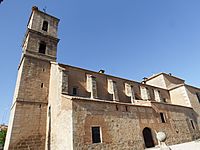Valdeverdeja facts for kids
Quick facts for kids
Valdeverdeja
|
|||
|---|---|---|---|
|
|||
| Country | |||
| Autonomous community | Castile-La Mancha | ||
| Province | Toledo | ||
| Area | |||
| • Total | 67 km2 (26 sq mi) | ||
| Elevation | 397 m (1,302 ft) | ||
| Population
(2018)
|
|||
| • Total | 586 | ||
| • Density | 8.75/km2 (22.65/sq mi) | ||
| Time zone | UTC+1 (CET) | ||
| • Summer (DST) | UTC+2 (CEST) | ||
Valdeverdeja is a small town, also known as a municipality, located in the province of Toledo in Castile-La Mancha, Spain. It's part of the Campana de Oropesa region. In 2018, about 586 people lived there. The town covers an area of 67 square kilometers.
Valdeverdeja is found at the western edge of the Toledo province. It sits right on the border of the Castilla-La Mancha region, next to the Cáceres province in Extremadura. The Tagus River curves around the town, forming the border between these two regions. The river is only about 3 kilometers away from the town center. Valdeverdeja is also close to La Jara and is located in a valley.
The town's coat of arms has three parts. One part shows a gold tower on a green background. Another part has gold chains crossed by a black stripe on a white background. The third part shows a white castle on a red background.
Contents
Getting Around Valdeverdeja
Valdeverdeja is close to the main highway that goes to Extremadura, called the A-5. You can reach it using local roads. For example, the TO-7121 road connects it to Oropesa, which is the main town in the region. The MC-4159 road goes to El Puente del Arzobispo, where it joins the MC-4100. Another road, the TO-7137, links Valdeverdeja to Berrocalejo.
Nature and Landscape
Valdeverdeja is built in the valley of the Tagus River. The land here is made of granite rocks, which form unique rocky areas called canchales.
The Tagus River flows through deep, narrow banks in this area. In the past, there were several water mills along the river, but they are not used anymore.
The plants and trees in Valdeverdeja are typical of the Mediterranean region. You'll find meadows with holm oaks and olive trees. There are also areas with broom and thyme plants.
Animals of Valdeverdeja
The local climate and plants create a home for many animals. In the past, you could find rabbits, rats, mice, and partridges. Larger animals like wild boars and foxes also live here. Birds include owls, eagle owls, and various types of eagles. You might also see vultures, swallows, and storks. Different kinds of fish like barbels and carp used to be common in the rivers. Some animals are now rare, but others, like vultures and certain eagles, are starting to recover.
Plants of Valdeverdeja
The plants in Valdeverdeja are typical of the Mediterranean area. Wild plants include holm oak trees, broom, thyme, and lavender. You can also find wild olive trees and poplars. Because farming is important here, you will see many olive and fig groves. These farms have become a natural part of the landscape.
How Valdeverdeja Makes Money
The economy of Valdeverdeja has always relied on farming and raising animals. There isn't much industry here. However, tourism, especially rural tourism, is slowly growing.
- Farming and Livestock: This has always been the main way people make a living. Farmers grow olive trees and cereals. They also use water from the Tagus River to irrigate their fields. Raising animals like cattle is also a part of the local economy.
- Industry: There is very little industry in Valdeverdeja. In the past, some mills used water power to help with farming activities. In the mid-1900s, an old mill was even turned into a power plant to make electricity. But overall, industrial work has not grown much here.
- Services and Tourism: Shops and services in Valdeverdeja mostly serve the local people. For many things, residents still need to go to bigger towns like Oropesa or Talavera. However, rural tourism is becoming more popular. This has led to more places for visitors to stay, like hotels and guesthouses.
Interesting Places to Visit
- The Church of San Blas: This church was built in the 1500s and made bigger in the 1700s. It has a cross shape and is known for its tall ceilings and dome.
- The Town Hall: This is a large building made of granite. It has beautiful arches supported by Tuscan columns.
- Hermitage of Nuestra Señora de los Desamparados: This small church was built in the 1700s on the site of an older church from the 1100s. It has a special set of religious sculptures called an "ordeal."
- Pozos Nuevos (New Wells): This is a unique place with many wells, each with a stone basin carved from a single piece of rock. It's considered an important historical site.
- Casa Curato: This is the rectory, or priest's house, of Valdeverdeja. It has a lovely front that faces the main square, with a beautiful iron fence. The main entrance is on San Blas street, through a gate that leads to a courtyard.
- Arch House: Built in 1876, this house is an important piece of architecture. It was declared a cultural heritage site in 1992. It features a large semicircular arch that connects two streets, with a curved ceiling and brick arches.
See also
 In Spanish: Valdeverdeja para niños
In Spanish: Valdeverdeja para niños





